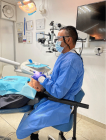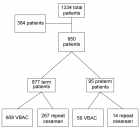Abstract
Research Article
Determination of body image perception and life satisfaction in patients undergoing hemodialysis
Sevil Biçer* and Gökçe Demir
Published: 09 July, 2020 | Volume 4 - Issue 2 | Pages: 016-021
Objective: This descriptive study was conducted in order to determine body image perception and life satisfaction of individuals undergoing hemodialysis treatment.
Material and methods: The population of the study consisted of individuals who were treated in hemodialysis units in the city center of Kırşehir. Patients. The study was conducted with 135 patients. Questionnaire, multidimensional body-self relations questionnaire, and satisfaction with life scale were used as data collection tool.
Results: According to study results, total mean scores of MBSRQ were significantly low in individuals who were older than 65, illiterate, had an extended family, were unemployed, had low income, suffered from disease and underwent hemodialysis treatment for 10 years and longer, had arteriovenous fistula in vascular insertion site, had body mass index within the class of morbid obese, and had no planned transplantation. SWLS mean scores of individuals, who were in the age group of 25-34 years, high school graduate, employed, described their income status as very high, had CRF for 6-12 months, underwent hemodialysis for 6-12 months, were waiting for renal transplantation, were significantly high. As a result of the correlation analysis made between body image and life satisfaction, it was determined that there was a positive, quite significant correlation
Conclusion: As a result, it was determined that hemodialysis patients were affected by body image and life satisfaction negatively due to many factors and the total score of body image scale was very low.
Read Full Article HTML DOI: 10.29328/journal.jnpr.1001032 Cite this Article Read Full Article PDF
Keywords:
Hemodialysis; Body image; Life satisfaction
References
- Kutner NG, Brogan D, Hall WD, Haber M, Daniels DS. Functional impairment, depression, and life satisfaction among older hemodialysis patients and age-matched controls: a prospective study. Arch Phys Med Rehabil. 2000; 81: 453-459. PubMed: https://www.ncbi.nlm.nih.gov/pubmed/10768535
- Sadeghian J, Roudsari DM, Seyedfatemi N, Rafiei H. Body-image disturbance: A comparative study among haemodialysis and kidney transplant patients. J Clin Diagn Res. 2016; 10: 14-16. PubMed: https://www.ncbi.nlm.nih.gov/pmc/articles/PMC4948440/
- Leung DKC. Psychosocial aspects in renal patients. Perit Dial Int. 2003; 23: 90-94. PubMed: https://pubmed.ncbi.nlm.nih.gov/17986567/
- Finnegan-John J, Thomas VJ. The psychosocial experience of patients with end-stage renal disease and its impact on quality of life: findings from a needs assessment to shape a service. ISRN Nephrol. 2013; 2013: 308986. PubMed: https://pubmed.ncbi.nlm.nih.gov/24959536/
- Leonard C. Shame and disgust-sensitivity in adult dialysis patients: Are these variables predictive of psychological morbidity, body image disturbance and quality of life? Doctorate Thesis. Department of Clinical Psychology University of Leicester, 2013. https://lra.le.ac.uk/bitstream/2381/28525/1/2013LeonardCLDClinPsy.pdf
- Oyekçin DG, Gülpek D, Şahin EM, Mete L. Depression, anxiety, body image, sexual functioning, and dyadic adjustment associated with dialysis type in chronic renal failure. Int J Psychiatry Med. 2012; 43: 227-241. PubMed: https://pubmed.ncbi.nlm.nih.gov/22978081/
- Muringai T, Noble H, McGowan A, Channey M. Dialysis access and the impact on body image: role of the nephrology nurse. Br J Nurs. 2008; 17: 362-366. PubMed: https://pubmed.ncbi.nlm.nih.gov/18414304/
- Erdem N, Karabulutlu E, Okanlı A, Tan M. Life satisfaction and hopelesness in hemodialysis patients. Journal of Human Sciences. 2004; 1: 1-14.
- Al Eissa M, Al Sulaiman M, Jondeby M, Karkar A, Barahmein M, et al. Factors affecting hemodialysis patients’ satisfaction with their dialysis therapy. Int J Nephrol. 2010; 1: 1-5.
- Eti AF. Body-Image Disturbance: A comparative study among haemodialysis and kidney transplant patients. J Çınar. 1996; 1: 4-6.
- Winstead BA, Cash TF Reliability and Validity of the body-self relations questionnaire: A new measure of body image. Paper presented at the meeting of the Southeastern Psychological Association, New Orleans, LA. 1984.
- Doğan O, Doğan S. Multidimensional Body -Self Relations Questionnaire hand book. Sivas Cumhuriyet University Faculty of Medicine Publications. 1992; 1-29.
- Diener E, Oishi S, Lucas ER. Subjective well-being: the science of happiness and life satisfaction. In: Synder CR, Lopez SJ [ed.] The Oxford handbook of positive psychology (2 ed.) Oxford University Press. 2009; 187-194.
- Köker S. Comparison of life satisfaction level of normal and troubled adolescents. Ankara University Institution of Social Sciences Master Thesis, Ankara, Turkey. 1991.
- Yetim Ü. Life satisfaction: A study based on the organization of personal projects. Soc Indicators Res.1993; 3: 277-289.
- Rezai R, Hejazi SH, Shahnazarian J, Mahmoudi M, Seidiandi SJ. To compare the patient's body imaging under haemodialysis treatment with patients renal transplantation. Payesh. 2009; 8: 279-287.
- Tan M, Karabulutlu E. The evaluation of the level of self-esteem and body image satisfaction of continuous ambulatory peritoneal dialysis patients. J Anotolia Nurs Health Sci. 2004; 7: 67-73.
- Eti AF. Approaches to nursing practices patients with experience changes in body image. J Çınar. 1998; 3: 79-82.
- Arkar H, Sarı Ö, Fidaner H. Relationships between quality of life, perceived social support, social network and loneliness in a Turkish sample. New Symposium. 2004; 42: 20-27.
- Haslam A, O’Brien A, Jetten J, Vormedal K, Penna S. Takingthe strain : Social identity, social support and the experience of stres. British J Soc Psychol. 2005; 44: 355-337. PubMed: https://pubmed.ncbi.nlm.nih.gov/16238844/
- Aşti T, Karam İ, Erci B. The experiences of loneliness, depression and social support of turkish patients with continous ambulatory peritoneal dialysis and their caregivers. J Clin Nurs. 2006; 15: 490-497. PubMed: https://www.ncbi.nlm.nih.gov/pubmed/16553763
- Kahraman A, Çınar S, Pınar R. Relationship of depression and perceived social support levels in hemodialysis patients. Turk Nephrol, Dialy Transplan J. 2006; 4: 130-133.
- Özçürümez G, Tanrıverdi N, Zileli L. Psychiatric and psychosocial aspects of chronic renal failure. Turk J Psychiatry. 2003; 14: 72-80. PubMed: https://www.ncbi.nlm.nih.gov/pubmed/12792842
- Tossani E, Cassano P, Favo M. Psychosocial factors in patients with chronic kidney disease. Seminars in Dialysis. 2002; 2: 73-81. PubMed:
- Turkey National Hemodialysis, Transplantation and Nephrology Registry Report Turkish Society of Nephrology Publications. 2014. Retrieved from: http://www.tsn.org.tr/folders/file/2014-REGISTRY-KITABI.pdf
- Atay M, Türkyılmaz S, Kavala AA, Bakuy V, Gülmaliyev C. Complications of arteriovenous fistula in hemodialysis patients. J Vascular Sur. 2017; 26: 128-131.
- Chao HH, Hills RK. Body image change in obese and overweight persons enrolled in weight loss intervention programs: A systematic review and meta-analysis. Plos One. 2015; 10: 15-20.
- Martin Ginis KA, McEwan D, Josse AR, Phillips SM. Body image change in obese and overweight women enrolled in a weight-loss intervention: The importance of perceived versus actual physical changes. Body Image. 2012; 3: 311-317. PubMed: https://www.ncbi.nlm.nih.gov/pubmed/22608984
- Jain P, Tiwari GK. Body Image Satisfaction and Life Satisfaction in HIV/AIDS Patients. Int J Indian Psychol. 2016; 3: 81-90.
Figures:
Similar Articles
-
Neuroanatomical profile of hemineglect in patient’s body image modificationMaurizio Falso*,Eleonora Cattaneo Psy. Neuroanatomical profile of hemineglect in patient’s body image modification. . 2020 doi: 10.29328/journal.jnpr.1001029; 4: 001-008
-
Determination of body image perception and life satisfaction in patients undergoing hemodialysisSevil Biçer*,Gökçe Demir. Determination of body image perception and life satisfaction in patients undergoing hemodialysis. . 2020 doi: 10.29328/journal.jnpr.1001032; 4: 016-021
Recently Viewed
-
Chronic endometritis in in vitro fertilization failure patientsAfaf T Elnashar*,Mohamed Sabry. Chronic endometritis in in vitro fertilization failure patients. Clin J Obstet Gynecol. 2020: doi: 10.29328/journal.cjog.1001073; 3: 175-181
-
Relation of Arachnophobia with ABO blood group systemMuhammad Imran Qadir,Sani E Zahra*. Relation of Arachnophobia with ABO blood group system. J Hematol Clin Res. 2019: doi: 10.29328/journal.jhcr.1001011; 3: 050-052
-
Preservation of Haemostasis with Anti-thrombotic Serotonin AntagonismMark IM Noble*,Angela J Drake-Holland. Preservation of Haemostasis with Anti-thrombotic Serotonin Antagonism. J Hematol Clin Res. 2017: doi: 10.29328/journal.jhcr.1001004; 1: 019-025
-
Neutrophil to Lymphocyte Ratio (NLR) in Peripheral Blood: A Novel and Simple Prognostic Predictor of Non-small Cell Lung Cancer (NSCLC)Xiaoli Zhang,Ziyuan Zou,Liyu Fan,Xinjie Xu,Yu Siyuan,Peng Luo*. Neutrophil to Lymphocyte Ratio (NLR) in Peripheral Blood: A Novel and Simple Prognostic Predictor of Non-small Cell Lung Cancer (NSCLC). J Hematol Clin Res. 2017: doi: 10.29328/journal.jhcr.1001002; 1: 011-013
-
Gilbert’s Syndrome Revealed by Hepatotoxicity of ImatinibImen Ben Amor*,Imen Frikha,Moez Medhaffer,Moez Elloumi. Gilbert’s Syndrome Revealed by Hepatotoxicity of Imatinib. Ann Clin Gastroenterol Hepatol. 2025: doi: 10.29328/journal.acgh.1001049; 9: 001-003
Most Viewed
-
Evaluation of Biostimulants Based on Recovered Protein Hydrolysates from Animal By-products as Plant Growth EnhancersH Pérez-Aguilar*, M Lacruz-Asaro, F Arán-Ais. Evaluation of Biostimulants Based on Recovered Protein Hydrolysates from Animal By-products as Plant Growth Enhancers. J Plant Sci Phytopathol. 2023 doi: 10.29328/journal.jpsp.1001104; 7: 042-047
-
Sinonasal Myxoma Extending into the Orbit in a 4-Year Old: A Case PresentationJulian A Purrinos*, Ramzi Younis. Sinonasal Myxoma Extending into the Orbit in a 4-Year Old: A Case Presentation. Arch Case Rep. 2024 doi: 10.29328/journal.acr.1001099; 8: 075-077
-
Feasibility study of magnetic sensing for detecting single-neuron action potentialsDenis Tonini,Kai Wu,Renata Saha,Jian-Ping Wang*. Feasibility study of magnetic sensing for detecting single-neuron action potentials. Ann Biomed Sci Eng. 2022 doi: 10.29328/journal.abse.1001018; 6: 019-029
-
Pediatric Dysgerminoma: Unveiling a Rare Ovarian TumorFaten Limaiem*, Khalil Saffar, Ahmed Halouani. Pediatric Dysgerminoma: Unveiling a Rare Ovarian Tumor. Arch Case Rep. 2024 doi: 10.29328/journal.acr.1001087; 8: 010-013
-
Physical activity can change the physiological and psychological circumstances during COVID-19 pandemic: A narrative reviewKhashayar Maroufi*. Physical activity can change the physiological and psychological circumstances during COVID-19 pandemic: A narrative review. J Sports Med Ther. 2021 doi: 10.29328/journal.jsmt.1001051; 6: 001-007

HSPI: We're glad you're here. Please click "create a new Query" if you are a new visitor to our website and need further information from us.
If you are already a member of our network and need to keep track of any developments regarding a question you have already submitted, click "take me to my Query."



















































































































































